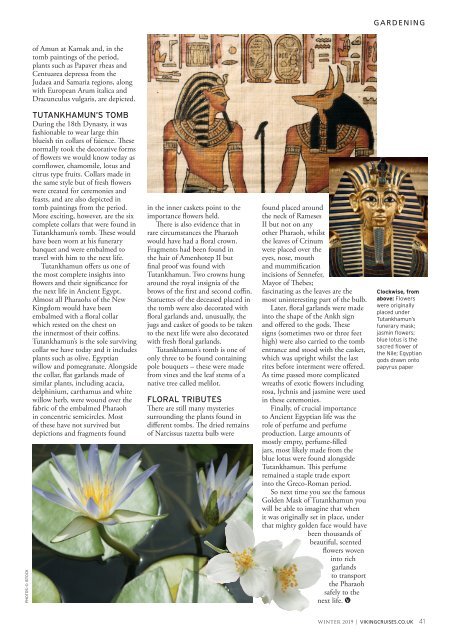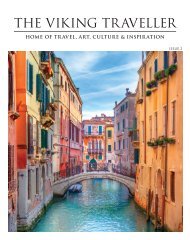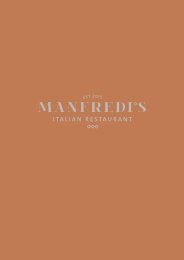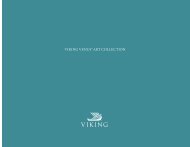Explore More Issue 18
Create successful ePaper yourself
Turn your PDF publications into a flip-book with our unique Google optimized e-Paper software.
GARDENING<br />
of Amun at Karnak and, in the<br />
tomb paintings of the period,<br />
plants such as Papaver rheas and<br />
Centuarea depressa from the<br />
Judaea and Samaria regions, along<br />
with European Arum italica and<br />
Dracunculus vulgaris, are depicted.<br />
PHOTOS: © ISTOCK<br />
TUTANKHAMUN’S TOMB<br />
During the <strong>18</strong>th Dynasty, it was<br />
fashionable to wear large thin<br />
blueish tin collars of faience. These<br />
normally took the decorative forms<br />
of flowers we would know today as<br />
cornflower, chamomile, lotus and<br />
citrus type fruits. Collars made in<br />
the same style but of fresh flowers<br />
were created for ceremonies and<br />
feasts, and are also depicted in<br />
tomb paintings from the period.<br />
<strong>More</strong> exciting, however, are the six<br />
complete collars that were found in<br />
Tutankhamun’s tomb. These would<br />
have been worn at his funerary<br />
banquet and were embalmed to<br />
travel with him to the next life.<br />
Tutankhamun offers us one of<br />
the most complete insights into<br />
flowers and their significance for<br />
the next life in Ancient Egypt.<br />
Almost all Pharaohs of the New<br />
Kingdom would have been<br />
embalmed with a floral collar<br />
which rested on the chest on<br />
the innermost of their coffins.<br />
Tutankhamun’s is the sole surviving<br />
collar we have today and it includes<br />
plants such as olive, Egyptian<br />
willow and pomegranate. Alongside<br />
the collar, flat garlands made of<br />
similar plants, including acacia,<br />
delphinium, carthamus and white<br />
willow herb, were wound over the<br />
fabric of the embalmed Pharaoh<br />
in concentric semicircles. Most<br />
of these have not survived but<br />
depictions and fragments found<br />
in the inner caskets point to the<br />
importance flowers held.<br />
There is also evidence that in<br />
rare circumstances the Pharaoh<br />
would have had a floral crown.<br />
Fragments had been found in<br />
the hair of Amenhotep II but<br />
final proof was found with<br />
Tutankhamun. Two crowns hung<br />
around the royal insignia of the<br />
brows of the first and second coffin.<br />
Statuettes of the deceased placed in<br />
the tomb were also decorated with<br />
floral garlands and, unusually, the<br />
jugs and casket of goods to be taken<br />
to the next life were also decorated<br />
with fresh floral garlands.<br />
Tutankhamun’s tomb is one of<br />
only three to be found containing<br />
pole bouquets – these were made<br />
from vines and the leaf stems of a<br />
native tree called melilot.<br />
FLORAL TRIBUTES<br />
There are still many mysteries<br />
surrounding the plants found in<br />
different tombs. The dried remains<br />
of Narcissus tazetta bulb were<br />
found placed around<br />
the neck of Rameses<br />
II but not on any<br />
other Pharaoh, whilst<br />
the leaves of Crinum<br />
were placed over the<br />
eyes, nose, mouth<br />
and mummification<br />
incisions of Sennefer,<br />
Mayor of Thebes;<br />
fascinating as the leaves are the<br />
most uninteresting part of the bulb.<br />
Later, floral garlands were made<br />
into the shape of the Ankh sign<br />
and offered to the gods. These<br />
signs (sometimes two or three feet<br />
high) were also carried to the tomb<br />
entrance and stood with the casket,<br />
which was upright whilst the last<br />
rites before interment were offered.<br />
As time passed more complicated<br />
wreaths of exotic flowers including<br />
rosa, lychnis and jasmine were used<br />
in these ceremonies.<br />
Finally, of crucial importance<br />
to Ancient Egyptian life was the<br />
role of perfume and perfume<br />
production. Large amounts of<br />
mostly empty, perfume-filled<br />
jars, most likely made from the<br />
blue lotus were found alongside<br />
Tutankhamun. This perfume<br />
remained a staple trade export<br />
into the Greco-Roman period.<br />
So next time you see the famous<br />
Golden Mask of Tutankhamun you<br />
will be able to imagine that when<br />
it was originally set in place, under<br />
that mighty golden face would have<br />
been thousands of<br />
beautiful, scented<br />
flowers woven<br />
into rich<br />
garlands<br />
to transport<br />
the Pharaoh<br />
safely to the<br />
next life.<br />
Clockwise, from<br />
above: Flowers<br />
were originally<br />
placed under<br />
Tutankhamun’s<br />
funerary mask;<br />
jasmin flowers;<br />
blue lotus is the<br />
sacred flower of<br />
the Nile; Egyptian<br />
gods drawn onto<br />
papyrus paper<br />
WINTER 2019 | VIKINGCRUISES.CO.UK 41<br />
040-041_EM<strong>18</strong>_PaulH.indd 41 05/11/2019 10:04

















